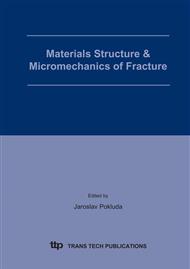p.123
p.127
p.131
p.135
p.139
p.143
p.147
p.151
p.155
Ab-Initio Study of Mechanical Properties of Transition-Metal Aluminides: A Case Study for Al3(V,Ti)
Abstract:
On the basis of ab-initio density-functional calculations we have analyzed the character of interatomic bonding in the intermetallic compounds Al3(V,Ti) with the D022 and L12 structures. In all structures we found an enhanced charge density along the Al-(V,Ti) bonds, a characteristic feature of covalent bonding. The bond strength is quantitatively examined by tensile deformations. The ideal strength of Al3V and Al3Ti under uniaxial tensile deformation was found to be significantly higher than that of both fcc Al and bcc V. We investigated also the changes of the interatomic bonding in Al3V during tensile deformations. We found that the covalent interplanar Al- V bonds disappear before reaching the maximal stress. The weakening of the bonding between the atomic planes during the deformation is accompanied by a strengthening of in-plane bonding and an enhanced covalent character of the intraplanar bonds. Interplanar bonding becomes more metallic under tensile deformation.
Info:
Periodical:
Pages:
139-142
Citation:
Online since:
April 2005
Authors:
Price:
Сopyright:
© 2005 Trans Tech Publications Ltd. All Rights Reserved
Share:
Citation:


